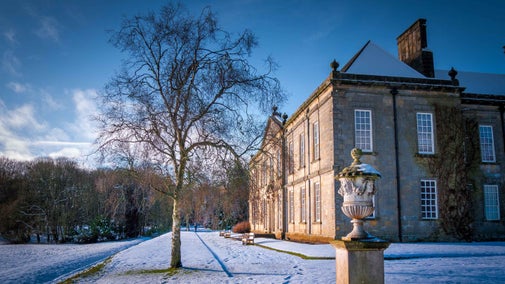
Wallington's collections
Explore the objects and works of art we care for at Wallington on the National Trust Collections website.

The house is now closed until Monday 30 March. Find out more about what you can do in the house and plan your spring 2026 visit to discover the treasures collected by 10 generations of the Blackett and Trevelyan families inside the house at Wallington. While it may be decorated relatively simply on the outside, inside lies a rich collection of ceramics, artworks, books and curiosities that tell fascinating stories of the people who lived here.
The house is now closed until Monday 30 March.
Step into the Entrance Hall and you’ll see a varied collection of ceramics on display in cabinets. It's one of the largest collections that the Trust looks after.
Continue into the house and you’ll reach the Central Hall. The original open courtyard was roofed over in the 1850s and the pre-Raphaelite artist William Bell Scott created eight large wall paintings for the space.
The paintings deserve a close inspection – they're a celebration of Northumbria, capturing 2,000 years of local history. Each work of art is packed with recognisable people and events, all in jewel-bright colours.
This room has seen its fair share of entertaining. The intricate ceiling in the Rococo style is one of three created by Pietro Lafranchini and cost Sir Walter Calverley Blackett a sum of £23 19s 6d. With their garlands and doubled-headed eagles, the ceilings at Wallington are considered some of Lafranchini’s best work.
Look out for the portrait of ‘Suky’ Trevelyan – it was painted by two of the greatest portrait painters of the time.
Originally this room was the Great Hall (and entrance) of the 1680s house. In the 1740s Sir Walter transformed it into the principal reception room. He raised the ceiling height to add drama and added lavish decoration in the Rococo style. You can see Sir Walter’s portrait, which was painted by Sir Joshua Reynolds, above the pianos.

This room was originally a drawing room but was converted by Sir Walter Calverley Trevelyan in 1853. It was a well-used and well-loved library, enjoyed by family, friends and tenants of the Trevelyan family. The library contains over 3,000 books and is considered to be one of the best 19th-century book collections cared for by the National Trust.
From the 1880s onwards the Parlour was used as a sitting room. Look out for the original William Morris wallpaper as well as paintings by Turner, Leighton and Burne-Jones.
By way of contrast, the kitchen gives you a taste of life ‘below stairs’. The dresser and tables made of scrubbed pine have seen many years of service, as have lots of the utensils around the room.
Pause for a moment beside the coal-fired stove and spare a thought for the back-breaking work carried out by the servants. The stove was used for cooking food and heating water, and it was the scullery maid's job to clean it out and relight it every morning.

A favourite of generations of visitors, the dolls' house room celebrates several homes in miniature. The oldest dolls’ house dates to 1835, while the Hammond House has 36 rooms, each lit by electricity.
This room also showcases 3,000 lead soldiers that the Trevelyan brothers played with.
At the bottom of the staircase, you'll see a Swiss ‘dragon sleigh’ dating back to the 1600s and John Wooten’s Dancing Dogs, painted in 1759.

Explore the objects and works of art we care for at Wallington on the National Trust Collections website.
Discover how key members of the Blackett family were instrumental in remodelling the Wallington Estate into the house and grounds we know today.

There's lots to keep the family entertained at Wallington, whatever the season. Look out for wildlife on the River Walk, zoom along the Dragon cycle trail or go wild in one of the play areas (play train currently closed). Don't forget our impressive selection of splashy puddles on soggy days; we've got the mud if you've got the wellies! For rumbling tummies, why not make a stop at the Clocktower Café or one of our kiosks?

Discover the colourful, fragrant plants in the Walled Garden, take in the different spaces and areas and look out for the peaceful Mary Pool.

Historic houses and buildings are full of stories, art and collections. Learn more about their past and plan your next visit.

From castles and country houses to pioneering feats of architecture, the National Trust cares for some of the North East’s most remarkable buildings. Step inside to uncover rich interiors, fascinating histories, and the lives of those who shaped these places. Whether you're drawn to dramatic design, innovation, or stories of the past, there's something to discover at every property.
